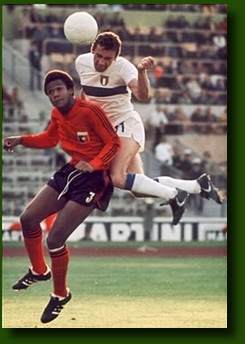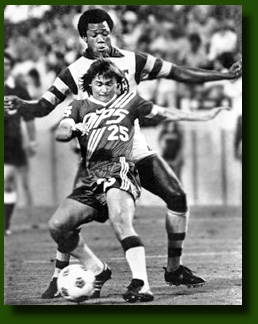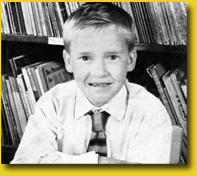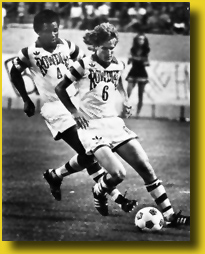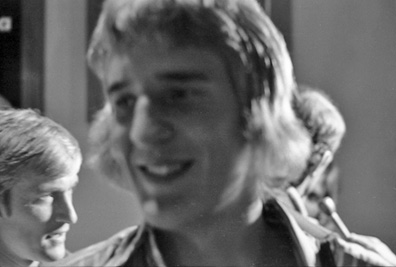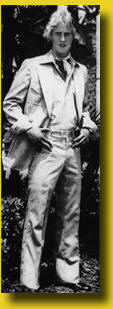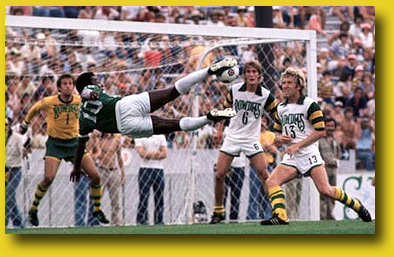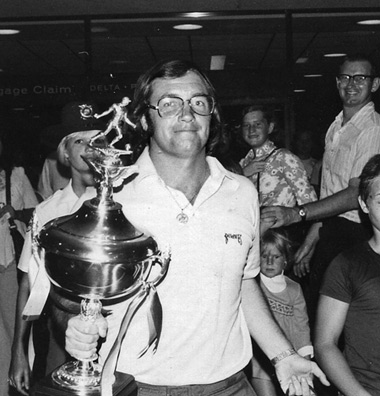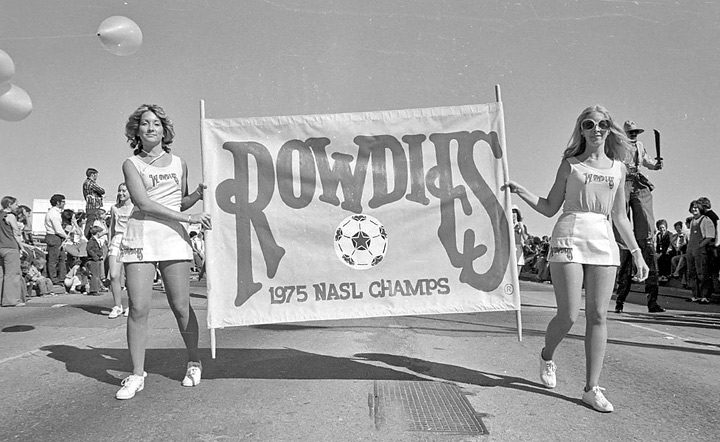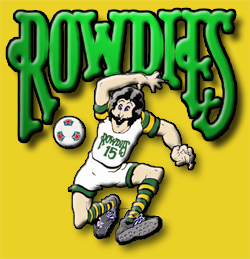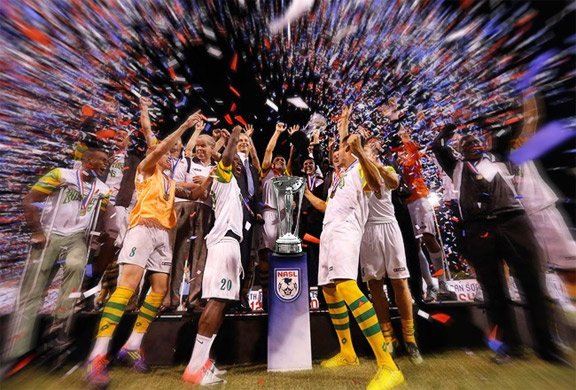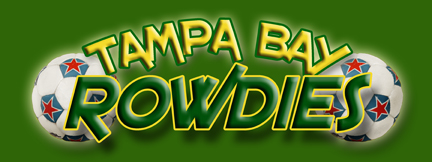
This site is not affiliated with the team or the NASL |
||||||||||||||||||||||||||
|
The Rowdies played ten seasons at Tampa Stadium and won their only Soccer Bowl championship in their 1975 inaugural season, defeating the Portland Timbers 2–0 on August 24.
|
||||||||||||||||||||||||||
|
|
Rowdies team captain John "The Bull" Boyle emerges from the gate tunnel with the championship trophy held over his head. |
|||||||||||||||||||||||||
|
The Tampa Bay Rowdies finished their inaugural season (1975) with the best record in the league at 16-6, thanks in large part to the 18-goal tally of forward Derek Smethurst. The Rowdies entered the playoffs as the favorites. After beating the Toronto Metros-Croatia 1-0 in the first round and the Miami Toros 3-0 in the second, the Rowdies, coached by Eddie Firmani, found themselves playing for the NASL title in the 1975 Soccer Bowl. In front of a crowd of 17,009 in San Jose and a national television audience on CBS, the Rowdies defeated the Portland Timbers 2-0.
Team captain John Boyle jumps into the arms of goalie Paul Hammond after their Soccer Bowl victory over the Portland Timbers in San Jose, CA. Rowdies press photo courtesy of MyTampaBayRowdies.blogspot.com |
||||||||||||||||||||||||||
|
"Captain Rowdie" John Boyle was a barrel-chested midfielder with legs as white as snow and hair as thin as a wheat crop during a summer drought. He became the role model for the club, as much because of his leadership as well as the fact that he knocked opponents "grass-over-tea kettle" when they came his way.
|
John Boyle (born 25 December 1946) is a now-retired Scottish footballer who played during the 1960s and 1970s. Born in Motherwell, he signed for London side as a 15-year-old whilst on holiday in the city. Boyle was one of the lesser-known, but nevertheless important, members of the successful Chelsea side of the period, usually playing in the midfield ball-winner role. He made his Chelsea debut in a League Cup semi-final against and ultimately picked up a winners medal in that competition the same year after also playing in Chelsea's two-legged final victory over. He played in Chelsea's FA Cup final loss two years later but missed out when they won their FA Cup final against in 1970 due to an injury. He made amends the following season, playing in both matches of Chelsea's successful UEFA Cup Winners' Cup final against Real Madrid in Athens. He left Chelsea in September 1973 and briefly played for both and Orient. Boyle was the owner of Simon the Tanner pub in London in the late 70s, early 80s. He currently lives in Kent with his wife and his granddaughter named Madeline. Newspaper articles
about John Boyle
"Timberrr - Rowdies Axe Portland 2-0"-August 25, 1975 news article |
|||||||||||||||||||||||||
|
|
||||||||||||||||||||||||||
|
Eddie Firmani Edwin Ronald "Eddie" Firmani was born to an Italian father and an English mother on August 7, 1933 in Cape Town, South Africa. Firmani's career began when he emigrated to England and was signed at age 16 as an apprentice goal-scorer to the Charlton Athletic F.C. From 1950 to 1955, he played in 100 games, scoring 50 goals (25 of which were scored in his last season). A $210,000 trade took him to Italy where he played for Sampadoria, scoring 52 goals from 1955 to 1958. Then, at the legendary Inter-Milan, he scored 48 goals in 3 seasons from 1957/58 to 1960/61. At F.C. Genoa, he scored 25 goals in 2 seasons from 1961/62 to 1962/63. When Firmani first arrived in Italy, the Italian fans dubbed him Il Tacchino (the Turkey) because of the funny way he flapped his elbows when he ran. Then when they saw the even funnier way he behaved after he scored--aloof to the Italian tradition of celebrating with hugs and kisses, as if he were almost bored with it all—they changed his name to Il Tacchino Freddo (the Cold Turkey).
Firmani represented the Italian national team 3 times and became the only foreign born player ever to score more than 150 goals in the defense-oriented Italian First Division. But Firmani wanted to return to England, so he rejoined his first club, Charlton Athletic for the 1963/64 season. He went on to score 62 goals in 5 combined seasons with Charlton and Southend United through 1967. In 1967 Firmani was appointed manager of the Southern London Club and retired as a player. In his second season in charge, he brought them up to a third place finish in the Second Division, just missing out on promotion. He was released in March 1970 with Charlton battling against relegation to the Third Division. He then was appointed the Asst. Manager of the First Division Club Crystal Palace. Continued at top of next column Firmani Player Career Statistics by year Eddie Firmani Bio at Wikipedia
|
Firmani then moved to North America and was hired to coach the Tampa Bay Rowdies inaugural season in 1975. He coached the team to victory in the Soccer Bowl, and the Eastern Division Title of the Atlantic Conference in 1976, and the Indoor Championship Title. He was named the NASL coach of the year in 1976 . Firmani even continued his playing career in Tampa when he played a short 18-minute span for the Rowdies in 1975!
On the shoulders of Clyde
Best and Doug Wark, Firmani hoists the
1976 Indoor Championship trophy. Photo at left from Eddie Firmani Appreciation Society provided by Ian Morris
He coached the Philadelphia Fury and Montreal Manic in the early '80s before returning to the Cosmos in 1984. After the NASL folded following the 1984 season, Firmani spent much of the next decade in the Middle East-- Kuwait, Oman and the United Arab Emirates, winning league titles there, too. Firmani was coaching Kazmah Sporting Club in Kuwait when the tanks and soldiers of Iraqi dictator Saddam Hussein came rolling through town. After returning to the US, he managed the Canadian side Montreal Impact in 1993 and Major League Soccer side New York/New Jersey MetroStars in 1996. "All the Way with Tampa Bay" Sept. 1975 Sports Illustrated article re Soccer Bowl victory
|
|||||||||||||||||||||||||
|
|
|
|||||||||||||||||||||||||
|
Clyde Best Best scored the second Rowdies goal in their 2-0 victory over the Portland Timbers. Clyde Cyril Best was a Bermudian football player (born February 24, 1951) who played as a striker for West Ham United. He was a prolific goal-scorer and a strong, powerful player with the skills of the traditional English centre forward, tough to dispossess when he had the ball and good in the air. He was a true fan favorite at West Ham, having played in 164 league games before joining the Rowdies on loan in 1975. Best was the team's 2nd leading scorer in 1974, having averaged a goal every 3 games. Best received his first cap at the age of fifteen playing for the Bermudian national team. Best played for the Rowdies in 1975-76. Afterward, he played for the Portland Timbers, Feyenoord in the Dutch Eredivisie, and the Toronto Blizzard of the NASL. He also coached the national team from 1997 to 1999. |
||||||||||||||||||||||||||
 Best was instrumental in the origins of
soccer at Irvine Valley College in Southern California, as a founding
member of the coaching staff along with Head Coach Martin McGrogan in
1993. He was inducted into the Bermuda National Sports Hall of Fame in
2004. He was awarded an MBE in the January 2006 New Year's Honors list for
services to soccer and the community in Bermuda. Best was instrumental in the origins of
soccer at Irvine Valley College in Southern California, as a founding
member of the coaching staff along with Head Coach Martin McGrogan in
1993. He was inducted into the Bermuda National Sports Hall of Fame in
2004. He was awarded an MBE in the January 2006 New Year's Honors list for
services to soccer and the community in Bermuda. |
||||||||||||||||||||||||||
|
|
||||||||||||||||||||||||||
|
Derek Smethurst
was born Oct. 1947 in Durban, S. Africa. He played soccer in his
native South Africa at Addington and Durban City.
From a sporting family, his father Norman was a player for Springbok in
the 1930s and brother Peter played for Johannesburg Ramblers and
Blackpool. He joined Chelsea F.C. in England in 1968. He scored a key goal for Chelsea against Manchester
City helping them win the semi-final match in the 1970/71 UEFA Cup
Winners' Cup. He transferred to 2nd Division Millwall for
the 1971-72 season before joining
the NASL and the Tampa Bay Rowdies from 1975 to 1978. Derek was
the first South African to win a European championship
the first foreign born player to win a European championship in England.
June 1, 1977 St.
Pete Times Article:
July 10, 1976 St. Pete Times article:
|
Derek
Smethurst Pick a Rowdies scoring record and chances are this crafty, deceptive South African owns it. Most regular season goals in a game (4), season (20) and career, to name a few. Smethurst scored 75 goals in just over 100 games in the NASL and led the Tampa Bay Rowdies of the NASL in goals scored for the three years he played with them. In June 1976, he scored 3 goals for the Rowdies and along with goals from Stewart Scullion and Clyde Best, demolished the NY Cosmos 5 -1, in front of 42,611 Tampa Stadium Fannies and a National television audience. After his days with the Rowdies, he played with the NASL's Seattle Sounders for the 1979 & 1980 seasons scoring a hat-trick for the Sounders in a home game against the Portland Timbers on June 30, 1979. He was the NASL's leading scorer in 1979. Derek also played in the NFL pre-season with the Tampa Bay Buccaneers as a placekicker and wore the jersey #12 in 1977. Derek's NFL career was short-lived; he was 1 - 2 on field goals and was waived due to a thigh injury.
Feb. 2009 Interview with Derek at Nigel's Webspace June 7, 1976 News Article on the Rowdies Rout of the Cosmos: New York Who? o?
Derek's 1960's footballer card
|
|||||||||||||||||||||||||
|
Smethurst scored a hat trick (3 goals) against the Cosmos. Goals Clyde Best and Stewart Scullion completed the 5-1 rout. Tampa Stadium was still in the process of renovations, the end zones had just been closed in and the skyboxes seen in the background, were still under construction in preparation for the Tampa Bay Buccaneers inaugural season. At left, a post-game interview of forward Derek Smethurst by Mario Machado. Photo courtesy of Derek Smethurst |
||||||||||||||||||||||||||
|
||||||||||||||||||||||||||
|
John Sissons
John
was born September 30, 1945 in Hayes, Middlesex and played for West Ham
United, Sheffield Wednesday, Norwich City and Chelsea. He played as inside
left for Middlesex and England Schoolboys, but was moved to outside
John is now a successful businessman in Cape Town, South Africa, having played out his career at Cape Town City, a very successful football club of the 60's and 70's in South Africa. |
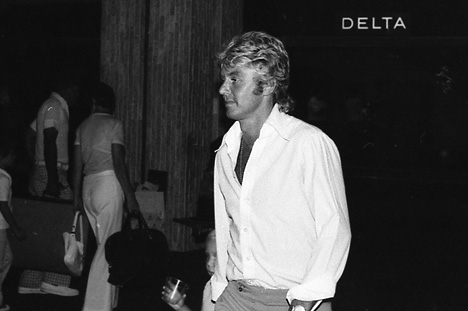 John's stats with the Rowdies and action shots June 30, 1975 news article on John's first Rowdie goals
|
|||||||||||||||||||||||||
|
|
Stewart "Scully" Scullion Scullion is a natural right-winger whose dribbling ability was unmatched on the Rowdies, using his skills to keep constant pressure on his opponents and forcing scoring opportunities. With the '75 Rowdies, he drilled in 8 goals and is credited with 7 assists, giving him a 23-point season, placing him as runner-up on the Rowdies to Smethurst's 42 points. Scullion was named by fans, peers and news media as the Rowdies' Most Valuable Player in 1975. Behind his dribbling and passing wizardry, the Rowdies ran a record-tying winning streak of 7 games, with very un-soccer-like scores of 6-1, 4-0 and 5-1. He missed the last 3 games of the '75 season with a hairline shin fracture he suffered in Philadelphia; a season closing losing streak which the Rowdies lost by a combined score of 2 - 9. Aug. 13, 1975 Newspaper Article: Rowdies Gold on the Line He returned to the lineup in time for the playoffs, and helped the team to the championship with a goal against the Miami Toros in the playoffs.
Coach Eddie Firmani and General Manager Beau Rogers negotiated with Watford F.C. in
Feb. of 1976 to purchase Scullion and make the feisty 5' 8", 150 lb.
winger the 14th permanent player on the Rowdies roster. |
|||||||||||||||||||||||||
| Stewart was born in 1947 in Bo Ness, Scotland. Before joining the Rowdies, he played 57 First Division matches with Sheffield United, before he returned to his original club Watford F.C. where he played in 275 league matches. Altogether, he played over 400 games in the English leagues. The then-29-year-old outside forward played for the Rowdies in 1975 on loan from Watford F.C. in England. | ||||||||||||||||||||||||||
|
Paul
"Boomer" Hammond
Hammond then played for the Houston Summit indoor soccer league team which drew many of its players from the NASL Hurricane. Hammond was selected as the Goalkeeper of the Year as the Summit ran to the best record only to fall to the champion New York Arrows in the playoff semifinals.
|
At the end of
the 1980 season, the Hurricane folded and Hammond went to the Seattle
Sounders dispersal sale. By this time Hammond had blossomed into an
excellent keeper. In 1982, the Sounders went to the championship game,
only to fall to the New York Cosmos by a score of 1-0. That year Hammond
was ranked as the third best keeper in the league. At the end of the
season, Hammond entered contract negotiations with the Sounders.
However, other opportunities beckoned. He had gained his U.S.
citizenship and the United States Soccer Federation had decided to enter
the U.S. national team into the NASL. Hammond elected to leave the
Sounders after they failed to meet his demands and signed with Team
America. When Team America finished the 1983 season with a 10-20 record,
the worst in the NASL, USSF withdrew the team from the league. At that
point Hammond moved to the Toronto Blizzard for the last season of the
NASL. In 1984, Hammond achieved his greatest success in the NASL when he
had the lowest goals against average in the league. That gained him
another Second Team All Star team selection. Hammond remained with the
Blizzard for the 1985 season, which they played in the National Soccer
League of Canada. In the 1975 playoffs, Hammond made a spectacular save of a Toronto penalty kick in the second half to preserve a 1-0 lead and mentally wilt the charging Metros. In the Soccer Bowl, Portland threatened four times in the last 12 minutes, but couldn't score, partly because of some fine goalkeeping by Paul Hammond. At the time on-loan from Third-Division Crystal Palace in England Eddie Firmani said "I think he is one of the best goalkeepers in England, but he doesn't get credit for it." Right: Hammond (as a Hurricane) watches a shot sail over the goal in a late 70's indoor Rowdies - Houston game at the Bayfront Center, St. Pete, FL |
|||||||||||||||||||||||||
|
Over his three years
with Oneonta State, Quraishi developed into one of the era's best
college players. He was a member of the 1972 Oneonta team which lost to
SIU-E in the NCAA Division II championship game. That year he was
selected to the 1972 State University of New York Conference All
Conference team, an honor he repeated in 1973 and 1974. Although the
team did not advance as far his junior and senior year, he was s
|
Farrukh "Rukie" Quraishi Farrukh was born November 13th, 1951 in Tehran, Iran and grew up in London. Drafted by the Rowdies with the first overall pick in the NASL college draft for 1975 as a midfielder/defender, he played a key role in the club's success both on and off the field. That season, despite being a rookie, Quraishi was named to the NASL All Star First Team. However, Quraishi remained committed to his education, which he had not yet finished, and continued to study while playing. In 1976 he graduated from Oneonta with a bachelors degree in sociology. Quraishi struggled with injuries, including a broken leg, which had a severe negative impact on his career. While he played 21 games as a rookie, he never again saw that many games in a season. In 1976 he played fifteen and in 1977 fourteen games. He lost the entire 1978 season due to the broken leg but came back strong in 1979, seeing time in eighteen games. However, injuries again reduced his playing time and he entered only nine games in 1980. He then moved to the expansion Calgary Boomers for whom he played one indoor season, 1980-1981. At the end of the indoor season, he retired from playing professionally and moved back to Tampa. After his career, he became a director of public relations with a McDonalds franchise. In 1992, he became Orlando, Florida's venue director for the 1994 World Cup. Later he became the General Manager of the Tampa Bay Mutiny. He is the co-owner of three minor league soccer teams, the Boston Bulldogs, Cape Cod Crusaders and the Boston Renegades. (Continued top left column) Farrukh's stats and action shots
|
|||||||||||||||||||||||||
|
Alex
"The Blonde Bomber" Pringle Born in Edinburgh, Scotland on Nov 8, 1948, the 5' 9", 160 lb. defender was purchased by Beau Rogers and Eddie Firmani in the winter of 1974-75 from the Dundee F.C. of Scotland and signed to the Rowdies. Alex scored the winning goal in the Rowdies first outdoor victory ever, a 2-1 overtime win over the Rochester Lancers. Alex was a stalwart of the Rowdies defense in 1975. Although hampered by injury for part of the season, he played in 14 games and still helped the Rowdie defense lead the league for the least number of goals allowed in the NASL that year. In 1976 he played 1,999 minutes in 22 games and was the only Rowdie to play in all 9 previous indoor matches. He played in all of the Rowdies playoff games in 1975 and 1976. By his own admission, his proudest moment came immediately after playing in the June 6, 1976 Rowdies/Cosmos match in Tampa Stadium. In front of over 42,000 fans and a live national television audience, the Rowdies destroyed the Cosmos 5-1. Pringle so completely shadowed superstar Pele that he earned the King of Soccer's ultimate respect and praise--Pele removed and awarded his fabled No. 10 jersey to Pringle as a tribute to his outstanding job in marking him in that match. Pringle then donated the shirt to raise funds to help pay expenses for an injured soccer player's auto accident related medical expenses. |
Alex played one game for the Rowdies in 1977, playing the full game against the Dallas Tornado at his customary left fullback position. In April of '77, the Rowdies announced the sale of Alex to the Washington Diplomats. The Rowdies had just acquired Stewart Jump back on loan from Crystal Palace, putting the team over the NASL imposed foreign player limit. Arsène Auguste, who had been playing center back since Jump's previous departure from the Rowdies, moved into Pringle's vacated position. Pringle then left to play the rest of the season for 17 games with the Washington Diplomats. Alex played 11 games for the Dips in 1978. June 7, 1976 Newspaper Articles on the Rowdies Rout of the Cosmos: New York Who? Bitter Humility April 11, 1977 St. Pete Times Article: Rowdies Sell Pringle to Dips |
|||||||||||||||||||||||||
|
The last addition to the Rowdies roster in July of 1975, "Augie" proved to be the Rowdies' "Ace in the hole" with his "Shot heard 'round the NASL" at the '75 Soccer Bowl. Augie came on late in the game as a sub for Malcolm Linton and in the 66th minute broke the scoreless tie with a cannon-like 35-yard goal to put the Rowdies up 1-0 against the Portland Timbers. The shot earned him his "Bigfoot" nickname. He logged 269 minutes in '75, playing in 6 games and 1,540 minutes in 17 games in '76. Overall, he played in 75 regular season games for the Rowdies from late 1975 through 1980, playing in 12 indoor matches with the Rowdies in 1979-80 during which time he scored 2 goals and an assist. He was often temporarily released by the Rowdies to play for the Haitian National Team, serving as their captain at times. In Haiti, he was nicknamed "Pelau." Auguste's toughest assignment upon joining the Rowdies was tackling English from his native French. In 1980 Augie joined the Ft. Lauderdale Strikers and played with such stars as Teofilo Cubillas, Gerd Mueller and goalie Jan van Beveren. Augie played 40 outdoor games with the Strikers from 1980 to 1981, and 12 indoor matches where he scored 5 goals and 3 assists. He joined the Pittsburgh Spirit of the MISL for the '81-'82 season where he scored a goal and an assist in 6 games.
Augie passed away from a heart attack in April of 1993. He is sorely missed by family, friends and fannies alike.
Auguste tackling Polish forward Augie's Rowdies stats and action photos
April 11, 1977
newspaper article: |
Arsène
"Big Foot"
Auguste Arsène Auguste was born February 3, 1951 in Haiti. He played club football with Racing Club Haïtien and to some he is considered legendary in the world of Haitian Soccer. At age 22 he was one of the elite Haitian soccer players that represented Haiti in the World Cup games in 1974 at Munich, Germany, making it to the final 16.
In the U.S., he was nominated to the NASL Second Team in both 1977 and 1978. In his homeland of Haiti, Auguste was enough of a national hero to be recognized most everywhere he went. The gazelle-like ground-gobbling stride of this 6' 3" 185-pounder was often too much for opposing center forwards to escape. He was discovered in 1975 on a scouting trip by Eddie Firmani who had gone up to watch Costa Rican midfielder Ringo Cantillo of the Cincinnati Comets play the New Jersey Brewers. But a tall, dark sweeper of the Brewers caught Firmani's attention. He watched Auguste winning all the balls and dominating the game; Firmani said he had to have him, made an offer, and shortly thereafter, Augie was a Rowdie.
|
|||||||||||||||||||||||||
|
"Iron Mike" Connell Born November 1, 1956 in Mayfair, Johannesburg, South Africa, his love for the game of soccer started on Dolphin Street in Mayfair. Mike played pick up soccer games with kids from the neighborhood on the street outside the house and on the soccer field two blocks from the house.
Bloch Park was where the semi professional soccer team Rangers Football Club practiced and where the youth teams of the club formed. He spent the day watching the local soccer legends and playing pick up games. At age 9, the coach of his brother's under 11 team saw him playing and invited him to play. And thus began Mike's soccer career. Through the early 70's Mike was selected to the all star teams and in 1971 and 1972 was selected to the South African Schoolboy team. Unfortunately South Africa was suspended from FIFA and no International games could be played. Alex Forbes, the manager of the professional team brought Mike into the first team squad. His full professional debut was made in 1972 at the age of 16 against Durban City. In 1973 Mike was invited to go on trial with Arsenal in England. He spent 6 months on trial but was not signed. He then returned to Rangers. In 1974 Eddie Firmani was scouting for players in South Africa. Rangers was playing Arcadia Shepherds who featured Steve Wegerle. After Mike was substituted his father confronted Alex Forbes on the field. An act Eddie Firmani realised gave him opportunity to get Mike. The "baby" of the 1975 Rowdies, Mike was nicknamed "Computer" by the fans of his South African club Johannesburg Rangers, due to his uncanny ability to analyze and play the game with a detachment that made a mockery of his age. Mike was popular with fans and players due to his enthusiastic and outgoing personality, and along with Farrukh Quaraishi, most popular with the teenage Fannies. Mike's maturity was impressive on the field; his versatility enabled him to play in the outside defender position, as well as sweeper and midfielder. (Mike was listed as midfielder in 1975 "Kick" magazines.) He logged 1,667 minutes in 20 regular season games in 1975, and played in all 3 post-season playoff games. He even scored a goal in the victory over the Toros in the playoffs. Mike missed the 1976 season due to military obligations to the army his native country, South Africa. Mike earned his "Iron Mike" nickname due to his consistency and leadership. In 1977, Mike played every minute of every game (26); he is the only Rowdie to ever accomplish this feat. He gained the respect of soccer superstar Pele during a 1977 match against the Cosmos; Pele paid Mike the traditional tribute by giving him his No. 10 jersey he wore during the game.
|
In 1978, Mike set a new team record for the most minutes played in a season, 2,458:39. He was named the top Rowdies defender by his teammates and came in 2nd in regular season MVP balloting. Mike was named the Rowdies' playoff MVP for 1978. In the off-season, he played for the Arcadia Shepherds. From 1975 through the mid 1980s, "Iron Mike" Connell was a mainstay of the Tampa Bay Rowdies. His quick thinking, even quicker reaction time, enabled him to intercept plays in the earliest stages. Mike was quick into the tackle, quick to recover, and strong in the air. His ability to see a scoring threat even before it materialized made him the backbone of the Rowdies defense. The memories of his playing career, which ended in 1984 when the NASL folded, included a four-year tenure as club captain and a 1980 all-star selection. Connell played nearly 350 games – and over 25,000 minutes - in the green and gold, the most of any ever to wear a Tampa Bay uniform. Connell did that in nine full seasons, playing regular season games - outdoor and indoor - as well as international exhibitions. If that’s not enough, Connell has built two businesses since his soccer retirement. He’s President of Mike Connell Enterprises. One business, Source and Solution, is a supplier of ATM and computer parts worldwide and recently formed a partnership with former teammate Mark Lindsay to provide networking solutions and support to small and medium-sized companies in the Tampa Bay area. Connell’s other company, MCE, produces embroidered corporate and logo wear for area companies. A long time ago in a sports galaxy far, far away, he was known as "Iron Mike," the most durable and, perhaps, the most recognizable of the area's first, and most loved, pro franchise, the Tampa Bay Rowdies. These days, more than 20 years removed from his North American Soccer League playing days, Mike Connell sometimes feels more like a rust bucket than a finely tuned athlete who matched wits with world famous soccer stars like Pele, George Best, Giorgio Chinaglia and Johan Cruyff to name a few.
July 20, 1975 Newspaper Article:
June 16, 1980 Newspaper articles: Nov. 19, 1981 Newspaper Article: This Mike is Liked
Dec. 18, 2007 Newspaper Article:
Photo by Masahide Tomikoshi / TOMIKOSHI PHOTOGRAPHY
Mike still keeps his hand – and feet – in the game he so loves, as a youth soccer coach in Tarpon Springs, as well as coaching with HCU and Temple Terrace youth soccer leagues.
Read full-page article from April 14,
1979 KICK Magazine: |
|||||||||||||||||||||||||
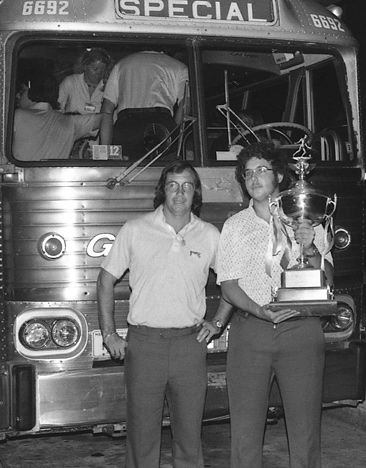 The nine-year lifespan of the NASL
(1975-84) remains fond memories to 40-year-olds and up living in the
bay area even today. More than a dozen Rowdie players make their homes
in the area. They embraced the community so well – and the community
embraced them as well back – that they chose to stay and made new
careers in business. They have also raised families here as well. Those
players continue to work in area soccer leagues, teaching
second-generation children of their fans of the 70s and 80s. And while
the glory of their accomplishments on the field lives on in print and
videotape, the essence of their legacy has a breathing, eating, talking
life of its own every day. The nine-year lifespan of the NASL
(1975-84) remains fond memories to 40-year-olds and up living in the
bay area even today. More than a dozen Rowdie players make their homes
in the area. They embraced the community so well – and the community
embraced them as well back – that they chose to stay and made new
careers in business. They have also raised families here as well. Those
players continue to work in area soccer leagues, teaching
second-generation children of their fans of the 70s and 80s. And while
the glory of their accomplishments on the field lives on in print and
videotape, the essence of their legacy has a breathing, eating, talking
life of its own every day.
|
||||||||||||||||||||||||||
|
|
||||||||||||||||||||||||||
| Information for this page was obtained from various sources, including but not limited to: www.tampabayrowdies.com, Wikipedia, Google News, NASL Jerseys.com, KICK Magazine, and various team websites. | ||||||||||||||||||||||||||
|
||||||||||||||||||||||||||
|
Recommended Related Links |
||||||||||||||||||||||||||
|
Tampa Natives on Facebook - You don't have to sign up to read the
posts or enjoy the pictures.
Rowdies theme song video courtesy of Ian Morris from his Tampa Bay Rowdies Blog spot.
|
www.tampabayrowdies.com - A great site where you can hear the Rowdies theme song and reminisce about the good ol' Rowdies days; everything that had anything to do with the old team is here: History, Team Stats, Honors, Wowdies, Reunion Game Photos, Team Photos, Player Photos, Video Clips, Fan Responses, Alumni and more. www.mytampabayrowdies.blogspot.com - Another great site where you can blog with former players and Fannies. A huge array of memorabilia provided by webmaster Ian Morris, including KICK Magazine info and photos from many sources, including bay area fannies and press photos. Rowdies Club History from Rowdiessoccer.com www.TBRowdies.com - The official website of the NEW team Tampa Bay Rowdies on Facebook (The NEW team)- You don't have to be a member to view the page or the photos, open to everyone. Sign up to connect with members. Tampa Bay Rowdies on Facebook - Group nostalgia site on the old team. Open to everyone. Sign up to connect with members or make comments.
|
|||||||||||||||||||||||||
|
The Tampa Bay Rowdies are once again NASL champions after 37 years! |
|
|
|
|
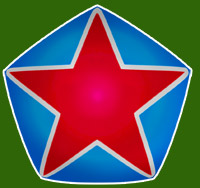
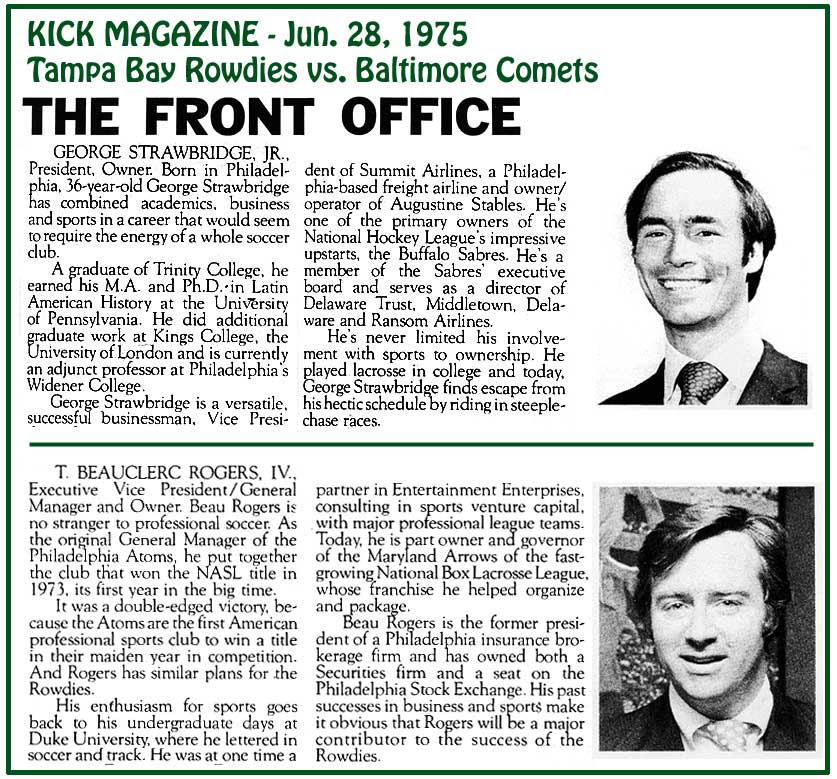
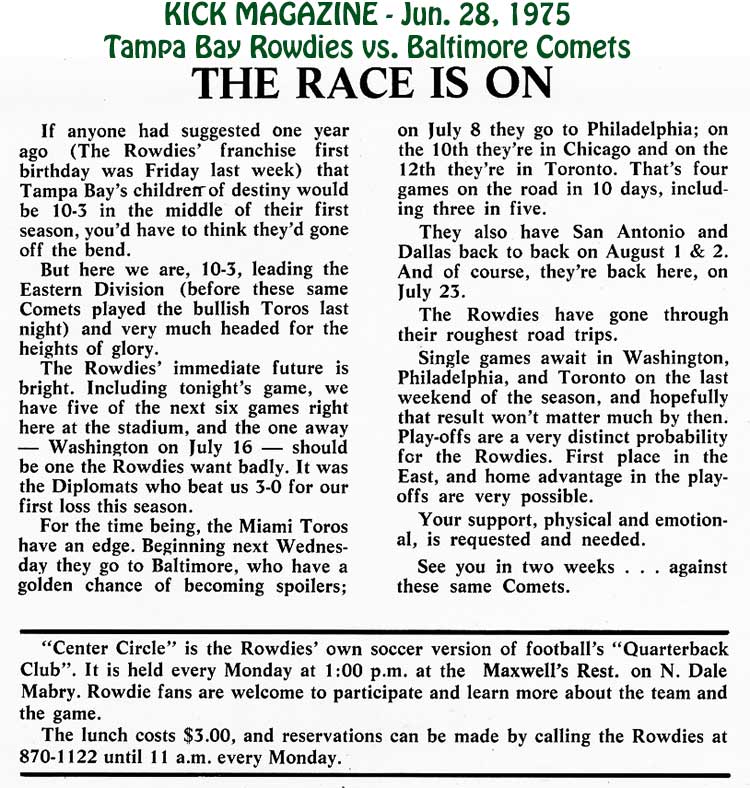
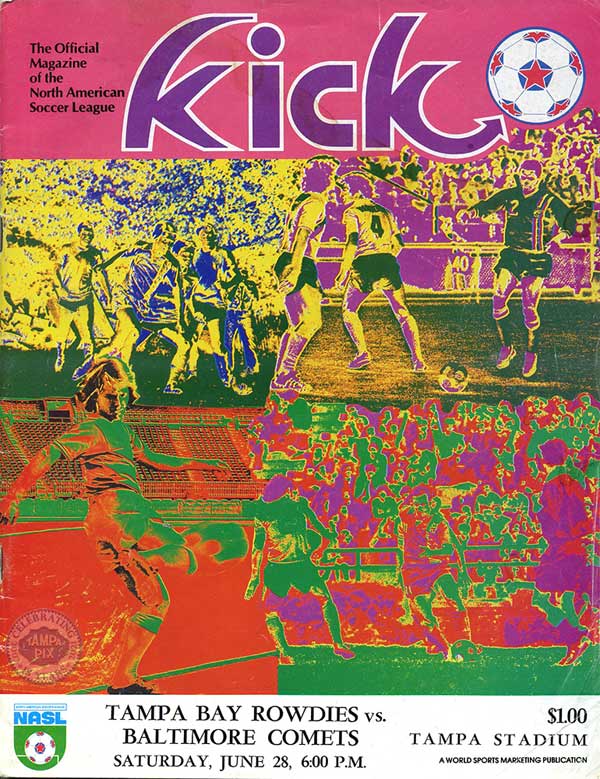
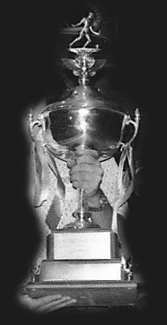
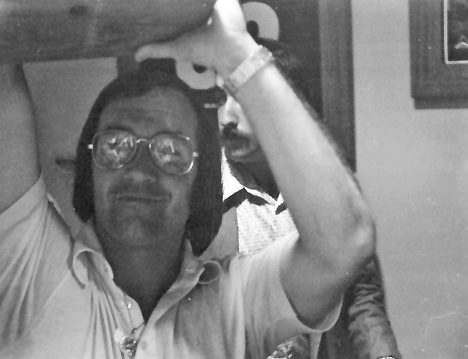
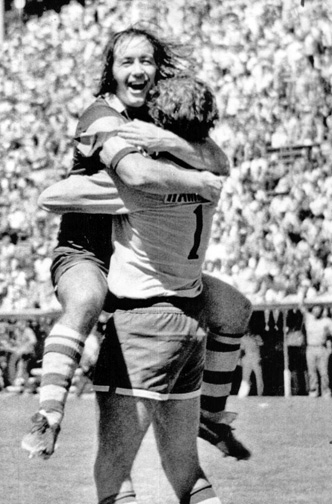
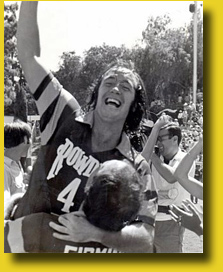

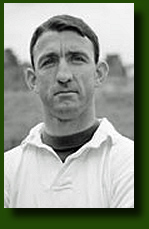 And when Firmani started scoring goals in bunches they had to change his
name again, to Il Tacchino d'Oro (the Golden Turkey).
And when Firmani started scoring goals in bunches they had to change his
name again, to Il Tacchino d'Oro (the Golden Turkey).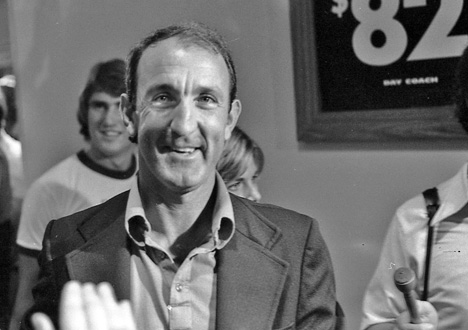
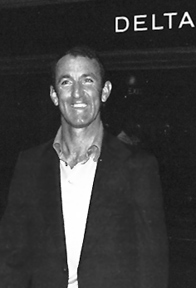
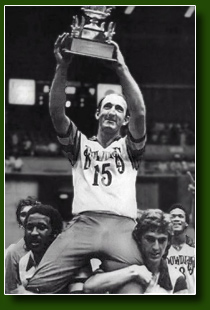
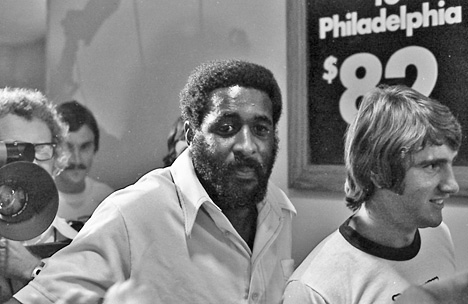
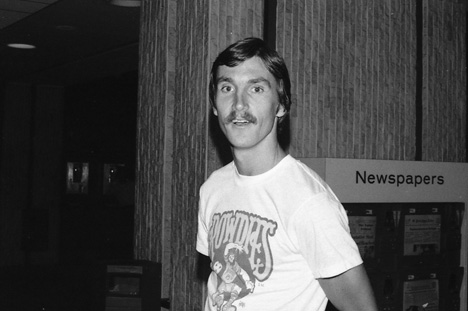
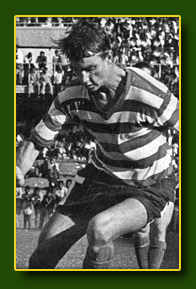
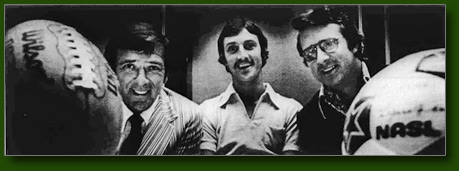
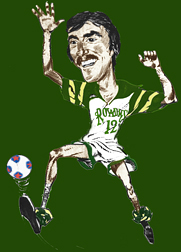
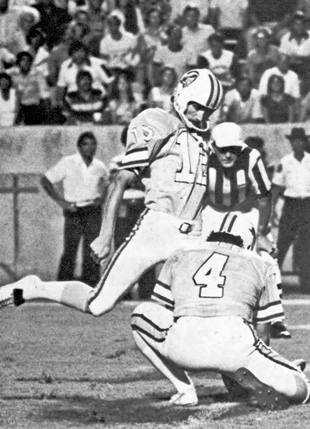
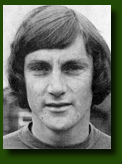
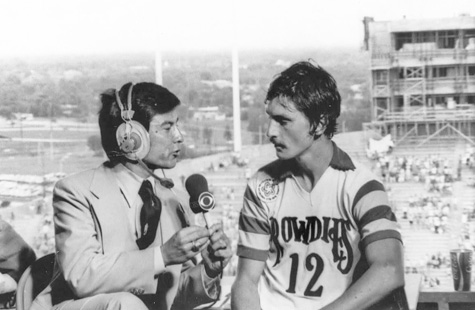 The
Rowdies humiliated the Cosmos in front of 42,611 fans on June 6, 1976,
the first time these two teams would meet.
The
Rowdies humiliated the Cosmos in front of 42,611 fans on June 6, 1976,
the first time these two teams would meet. 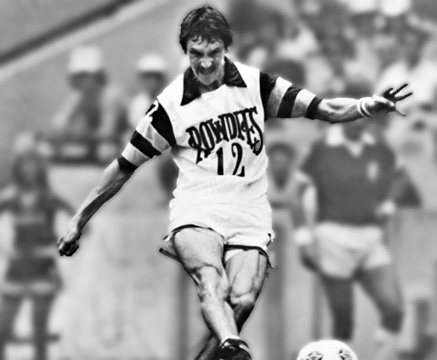 Beautiful
defensive play in the Rowdies penalty area by Tommy "The Tank"
Smith results in a turnover and a pass to Lenny Glover at the top
of the Rowdies' penalty box, who runs solo through the Cosmos
midfield, challenged briefly only once. Ten yards from the
top of the Cosmos penalty area, he passes forward and center, to a
sprinting Smethurst who once again has positioned himself
perfectly between two Cosmos defenders "all by himself". As
he receives the pass, he cuts left to the center of the arc at the
top of the box, faking out the defender ahead of him, and fires a
left-footed bullet from the top of the box to the right of and
past a diving Kuykendall at the goalie box. A hat
trick for Derek and the score is 4-0 Rowdies. New York
appeals for an offsides call on Smethurst but the play stands.
Derek is clearly onside as the ball is passed.
Beautiful
defensive play in the Rowdies penalty area by Tommy "The Tank"
Smith results in a turnover and a pass to Lenny Glover at the top
of the Rowdies' penalty box, who runs solo through the Cosmos
midfield, challenged briefly only once. Ten yards from the
top of the Cosmos penalty area, he passes forward and center, to a
sprinting Smethurst who once again has positioned himself
perfectly between two Cosmos defenders "all by himself". As
he receives the pass, he cuts left to the center of the arc at the
top of the box, faking out the defender ahead of him, and fires a
left-footed bullet from the top of the box to the right of and
past a diving Kuykendall at the goalie box. A hat
trick for Derek and the score is 4-0 Rowdies. New York
appeals for an offsides call on Smethurst but the play stands.
Derek is clearly onside as the ball is passed.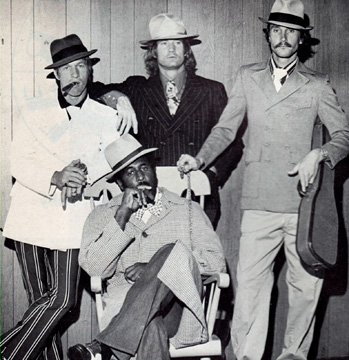 Rodney
Marsh works his magic at the Cosmos end, near the 35-yard
"Shootout" line. With his back toward goal, and moving away
from it, a defender attacks behind him as he fakes left, slips to
the turf, recovers and passes right, to the near side where
Smethurst takes the pass at just beyond the 35-yard line. He
takes several strides toward the goal then sends a long,
left-footed cross just over the penalty spot where a charging
Cosmos defender heads it straight upfield away from goal.
Charging Rowdies winger Stewart Scullion takes it under control
just inside the penalty arc dribbles forward a few yards and sends
the ball screaming toward the center of the goal. A Cosmos
defender just outside the goalie box sticks out his leg to block
the shot but deflects the ball slightly and it sails past the now
shell-shocked Cosmos goalie. Kuykendall sits on the ground
and motions toward his chest to his defender, as if to say, "I had
it, I had it." Mario Machado points out "an interesting
thing," the Rowdies's goals were all scored by 3 of the 4
members of "Murderers Row."
Rodney
Marsh works his magic at the Cosmos end, near the 35-yard
"Shootout" line. With his back toward goal, and moving away
from it, a defender attacks behind him as he fakes left, slips to
the turf, recovers and passes right, to the near side where
Smethurst takes the pass at just beyond the 35-yard line. He
takes several strides toward the goal then sends a long,
left-footed cross just over the penalty spot where a charging
Cosmos defender heads it straight upfield away from goal.
Charging Rowdies winger Stewart Scullion takes it under control
just inside the penalty arc dribbles forward a few yards and sends
the ball screaming toward the center of the goal. A Cosmos
defender just outside the goalie box sticks out his leg to block
the shot but deflects the ball slightly and it sails past the now
shell-shocked Cosmos goalie. Kuykendall sits on the ground
and motions toward his chest to his defender, as if to say, "I had
it, I had it." Mario Machado points out "an interesting
thing," the Rowdies's goals were all scored by 3 of the 4
members of "Murderers Row." 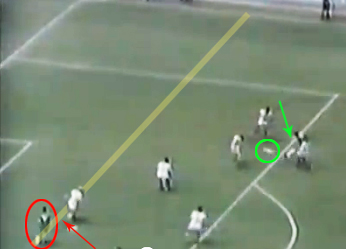
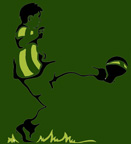
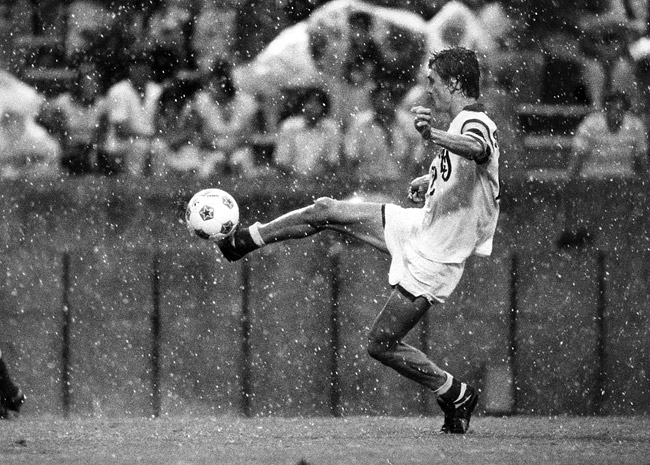
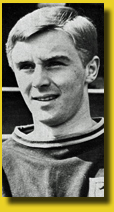 left
by Hammers manager Ron Greenwood. He made his senior debut for the East
London club on May 4, 1963, a home game against Blackburn Rovers. He
became the youngest player to score in an FA Cup Final at Wembley, in May
1964, and second youngest to appear behind his Preston North End
counterpart Howard Kendall. He went on to play 213 league (37 goals) and
52 cup (16 goals) games for West Ham. Sissons moved to Wednesday in 1970
for £60,000. He made 115 league appearances for the northerners, scoring
14 goals, before moving to Norwich, where he rejoined former team-mate
John Bond. He played for West London club Chelsea 11 times during the
1974-75 season before leaving to play under
Frank Lord in Cape Town. John was part of the NASL champion Tampa Bay
Rowdies in 1975.
left
by Hammers manager Ron Greenwood. He made his senior debut for the East
London club on May 4, 1963, a home game against Blackburn Rovers. He
became the youngest player to score in an FA Cup Final at Wembley, in May
1964, and second youngest to appear behind his Preston North End
counterpart Howard Kendall. He went on to play 213 league (37 goals) and
52 cup (16 goals) games for West Ham. Sissons moved to Wednesday in 1970
for £60,000. He made 115 league appearances for the northerners, scoring
14 goals, before moving to Norwich, where he rejoined former team-mate
John Bond. He played for West London club Chelsea 11 times during the
1974-75 season before leaving to play under
Frank Lord in Cape Town. John was part of the NASL champion Tampa Bay
Rowdies in 1975. 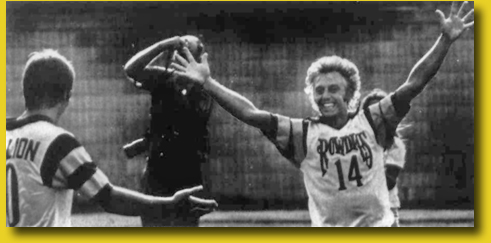
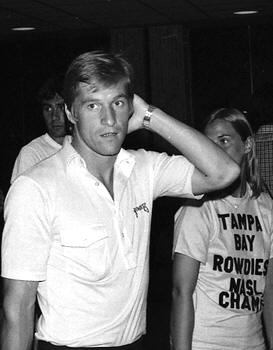
 Born
in Nottingham, England on July 26, 1953, Hammond was an apprentice with
English First Division club
Born
in Nottingham, England on July 26, 1953, Hammond was an apprentice with
English First Division club
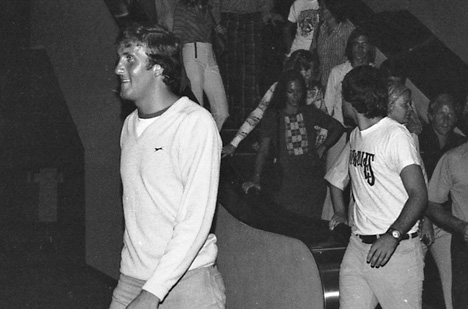
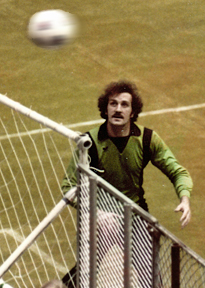
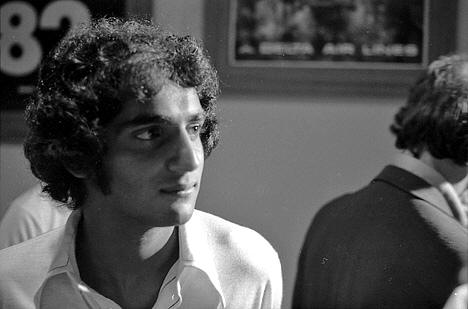
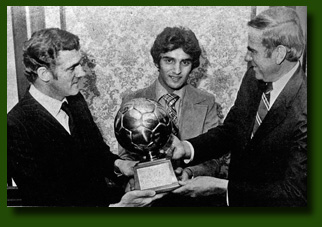 howered
with accolades, being named a first team All American in 1973 and 1974.
He capped this when he was named the 1974 Hermann Trophy winner as the
best collegiate player in the nation. Oneonta State inducted Quraishi
into its Athletic Hall of Fame in 1999.
howered
with accolades, being named a first team All American in 1973 and 1974.
He capped this when he was named the 1974 Hermann Trophy winner as the
best collegiate player in the nation. Oneonta State inducted Quraishi
into its Athletic Hall of Fame in 1999.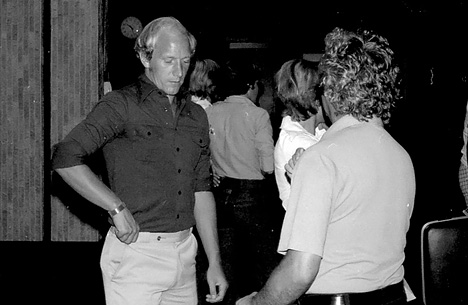
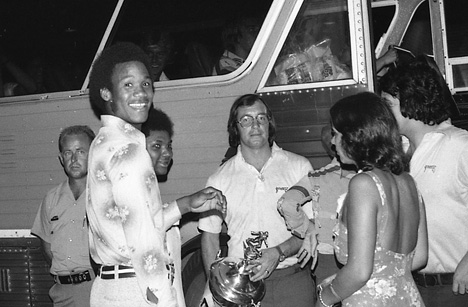
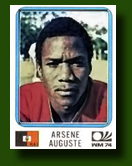 Auguste
was a fine athlete, fearless defender and excellent sportsman whose
physical prowess and skill was obvious through outstanding power on the
field.
He
brought pride and honor to all Haitians, learning plenty from watching
his older brother Andre Auguste who was an outstanding defender for the
Hatian Soccer club "Racing." After his times in Florida, he later moved
to Flatbush, Brooklyn, NY where his brother and sister lived, along with
his children. He later returned to Florida and played again for
the Rowdies during their AISA indoor season 1986-87.
Auguste
was a fine athlete, fearless defender and excellent sportsman whose
physical prowess and skill was obvious through outstanding power on the
field.
He
brought pride and honor to all Haitians, learning plenty from watching
his older brother Andre Auguste who was an outstanding defender for the
Hatian Soccer club "Racing." After his times in Florida, he later moved
to Flatbush, Brooklyn, NY where his brother and sister lived, along with
his children. He later returned to Florida and played again for
the Rowdies during their AISA indoor season 1986-87.